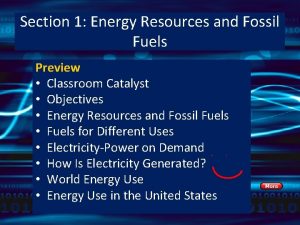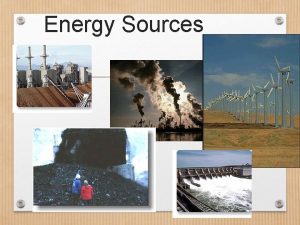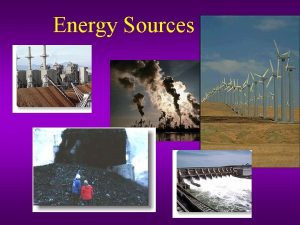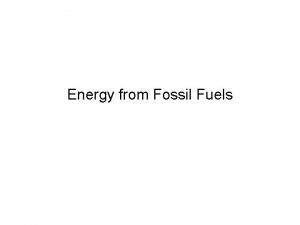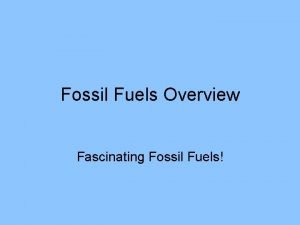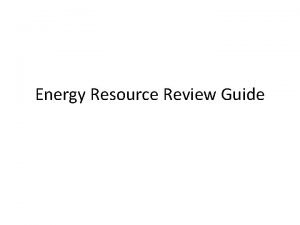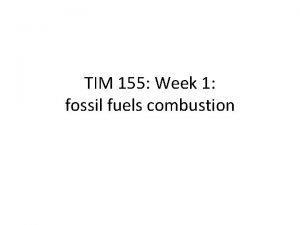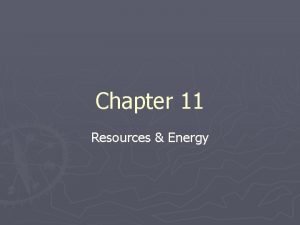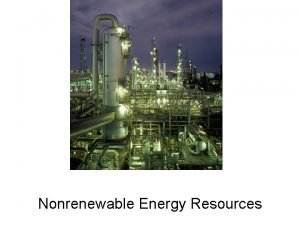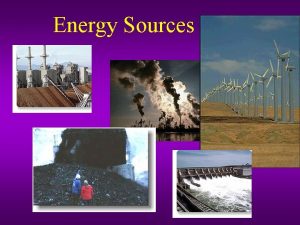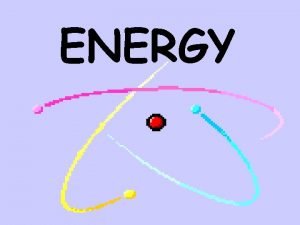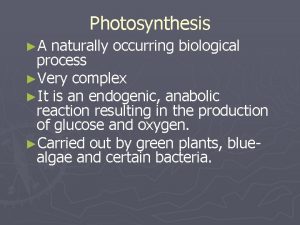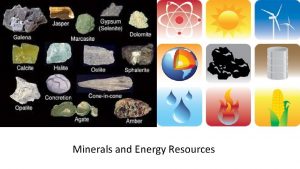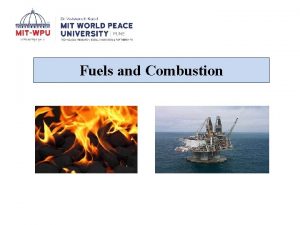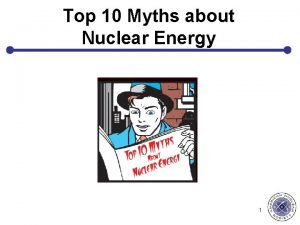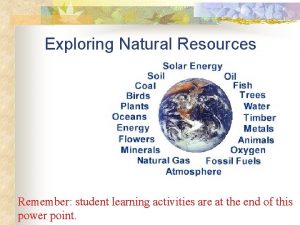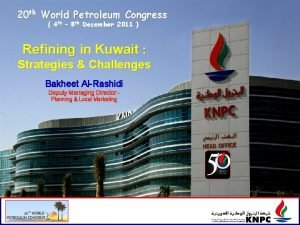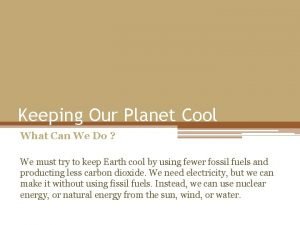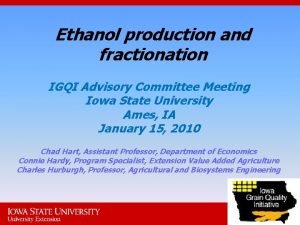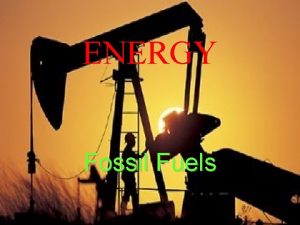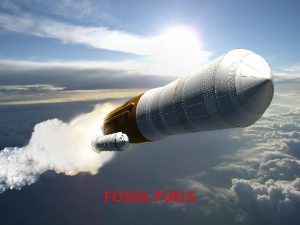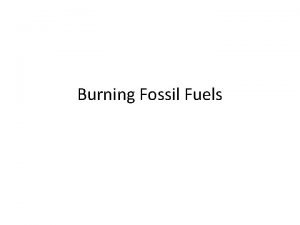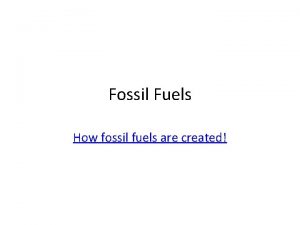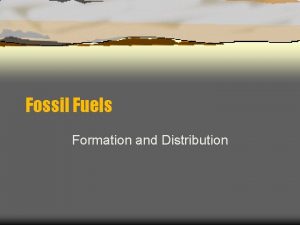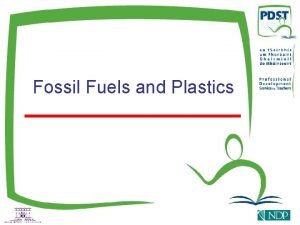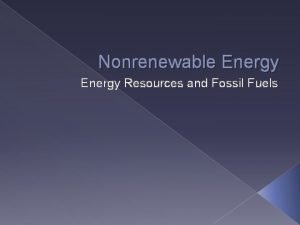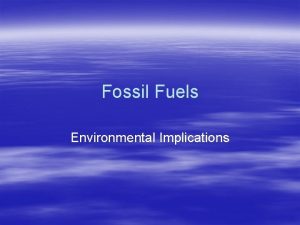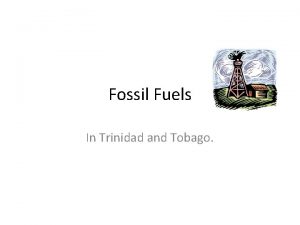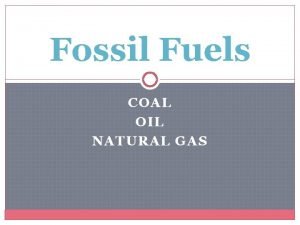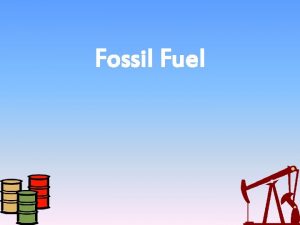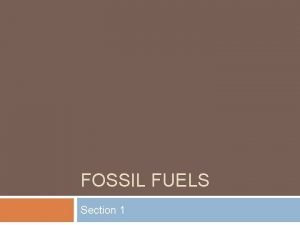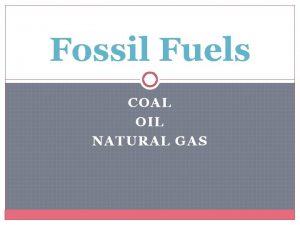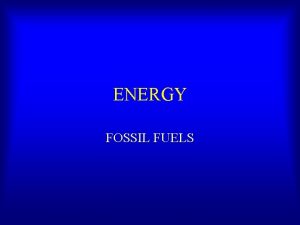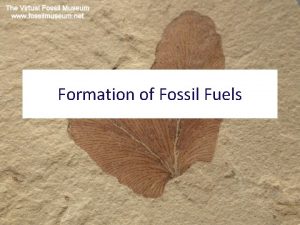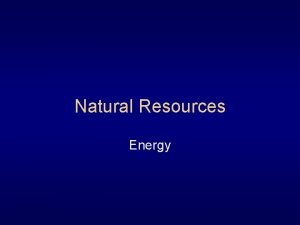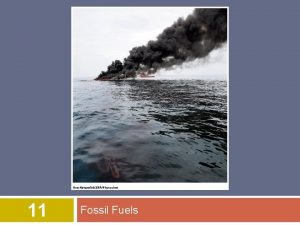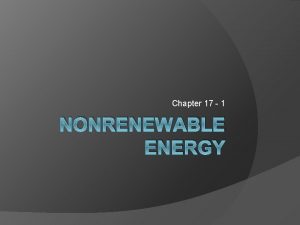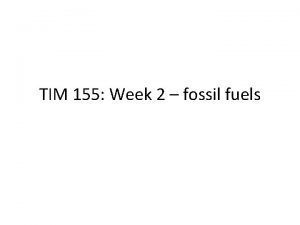Chapter 18 Fossil Fuels and the Environment Fossil































- Slides: 31

Chapter 18 Fossil Fuels and the Environment

Fossil Fuels Forms of stored solar energy created from incomplete biological decomposition of dead organic matter • Crude Oil • Natural Gas • Coal • Also, Oil Shale & Tarsands

Crude Oil and Natural Gas • Crude Oil – Naturally occurring petroleum, normally pumped from wells in oil fields. – Refinement of crude oil produces most of the petroleum products we use today • Natural Gas – Naturally occurring gaseous hydrocarbon generally produced in association with crude oil or from gas wells – An important efficient and clean burning fuel commonly used in homes and industry


Geology of Oil & Gas • Oil & gas found primarily along geologically young tectonic belts at plate boundaries – Source Rock – source material for oil & gas. Fine grained, organic rich sediment, at least 500 m deep – High pressure and high temperature, initiates the chemical transformation & upward migration of gas & oil (relatively light) to reservoir rock

Geology Cont’d Reservoir Rock: coarser grain, porous sandstone or limestone. Empty spaces store oil &/or gas. Cap Rock: traps oil or gas in a pocket in the reservoir rock. Usually shale – very fine grained sedimentary rock Two types of Traps: Anticline (arch shape) Fault (fracture in rock)

Activity • Draw these next slides


Petroleum Production • Primary Production – simply pumping – Recovery only 25% of reserve • Enhanced Production – steam, water, CO 2 or N 2 are injected into reservoir to push oil toward the well




Natural Gas • Only begun to seriously look for natural gas & its’ potential uses – (powering of cars) • Drawback: transported through pipelines • Worldwide estimate of recoverable nat. gas is 165 trillion m 3 - could last 70 years • Much of it is in the US • Considered a clean fuel – less pollutants, less environmental problems

Drilling and Fracking • Youtube video

Environmental Effects of Oil and Natural Gas • Recovery: – Use of land – Pollution of surface and groundwaters – Air pollutants – Land subsidence ( sinking) – Loss of ecosystems – Release of drilling muds (heavy metals) – Aesthetics (presence of rigs) • Refining: soil, water and air pollution – spills & leaks • Delivery and Use: energy to power automobiles, produce electricity, etc. Possible spills and air pollution form use


Coal • Solid, brittle, carbonaceous rock formed from partially decomposed vegetation buried in a sedimentary environment. • Total recoverable resource = 250 billion Metric tons ( 250 yrs )


Coal Composition • Classified according to energy content and sulfur content – Anthracite high energy – Bituminous – Subbitumious (low sulfur) – Lignite (low sulfur) low energy

Content cont’d • Low sulfur coal emits less SO 2. Therefore more desirable fuel • High sulfur coal can be treated before, during or after combustion to reduce sulfur content – This is done on the East coast of US. It is more expensive, but more economical than transporting low sulfur coal from the West •


Coal Mining and the Environment • Strip Mining – A surface mining process in which the overlying layer of soil and rock is stripped off to reach the coal (Cheap & Easy)

Impacts • Acid mine drainage: acid water from mine site is formed from rainwater coming in contact with spoil banks (rock debris) that contains Fe. S 2 (pyrite – common in sedimentary rock). This forms H 2 SO 4 – sulfuric acid – which infiltrates the surface and groundwater. • Good reclamation practices would help • 1000’s of km of land have been disturbed by strip mining, but only 50% has gone through reclamation processes

Impacts cont’d • Surface Mining Control & Reclamation Act of 1977 – US Gov’t requires that mined land be restored to support its pre-mining use.

• Transport of Coal • The Future of Coal – Scrubbing: removes sulfur dioxides • Allowance Trading – Reduces pollution – EPA grants utility companies tradable allowances for polluting

Underground Mining • 40% of coal is mined this way in the US • Dangers = collapse, fire, explosions, respiratory illness • Environmental Problems: – Acid mine drainage – Land subsidence – Coal fires in mines

Coal & the environment • Coal is used to produce electricity, synthetic oil & synthetic gas • Burning coal accounts for 60% of electricity used in US (25% of all energy consumed) • Coal is 90% of fossil fuel reserves in US – (enough for several hundred yrs for US population) – PROBLEMS: emissions of SO 2, NO & CO 2 Clean Air Act of 1990 – mandated that sulfur dioxide emissions be reduced by 70% - 90% This has forced the birth of new technologies

Allowance Trading • EPA grants utility companies tradable allowances for polluting • 1 allowance = 1 ton of SO 2 emissions • If you don’t use your allowance you can trade or sell them. • Encourages competition for cleaner emissions and reduces pollution.

Oil Shale and Tar Sands • Oil Shale – A fine-grained sedimentary rock that must be heated to extract the oil – One ton of oil shale produces 60 liters of oil – (Colorado, Utah & Wyoming) • Tar Sands – Sedimentary rocks or sands impregnated with tar oil, asphalt or bitumen – Wash the sand with hot water to extract oil – Alberta, Canada

Coal-Bed Methane • In the chemical process that converts decomposed organic matter into coal – methane is formed (in large amounts) • Currently two areas in our nation are recovering coal-bed methane – Utah & Wyoming • Wells are cheap ($100, 000 compared to several million for oil wells) • Problems: – Lg amounts of water are used to extract the methane – water becomes contaminated and disposal is a problem. – Migration of methane into urban areas (colorless, odorless and highly explosive

Methane Hydrates • White ice-like compound made up of molecules of methane gas trapped in “cages” of frozen water in the sediments of the deep seafloor • Formed due to microbial digestion of organic matter in sediments on the seafloor. • Discovered 30 yrs ago • Needs high pressure and low temps. Methane hydrate decomposes rapidly as press. & temp change and releases methane • Potential energy source – difficult to mine, bc found along lower continental slopes at greater than 1 km in depth
 Pros and cons of oil energy
Pros and cons of oil energy Similarities between biofuels and fossil fuels
Similarities between biofuels and fossil fuels Fossil fuel deposits
Fossil fuel deposits Fossil fuel energy advantages and disadvantages
Fossil fuel energy advantages and disadvantages Benefits of using fossil fuels
Benefits of using fossil fuels Advantages of using fossil fuels
Advantages of using fossil fuels Is petroleum a fossil fuel
Is petroleum a fossil fuel Fossil fuels include
Fossil fuels include Fossil fuels summary
Fossil fuels summary Fossil fuels include
Fossil fuels include Fossil fuels formula
Fossil fuels formula Fossil fuels
Fossil fuels Advantages and disadvantages of nonrenewable energy
Advantages and disadvantages of nonrenewable energy Benefits of using fossil fuels
Benefits of using fossil fuels The oldest source of energy
The oldest source of energy Resources that can be replaced.
Resources that can be replaced. Minerals and fuels
Minerals and fuels Minerals and fuels
Minerals and fuels Financial environment of business
Financial environment of business Classification of chemical fuels
Classification of chemical fuels Support nuclear energy
Support nuclear energy Classification of resources on the basis of exhaustibility
Classification of resources on the basis of exhaustibility Fuels
Fuels What are fissil fuels
What are fissil fuels Igqi
Igqi Hình ảnh bộ gõ cơ thể búng tay
Hình ảnh bộ gõ cơ thể búng tay Ng-html
Ng-html Bổ thể
Bổ thể Tỉ lệ cơ thể trẻ em
Tỉ lệ cơ thể trẻ em Gấu đi như thế nào
Gấu đi như thế nào Tư thế worm breton là gì
Tư thế worm breton là gì Chúa sống lại
Chúa sống lại


